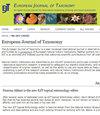安第斯巨人:厄瓜多尔的 Priscula 蜘蛛,附物种群和卵囊同形注释(Araneae: Pholcidae)
IF 1.3
3区 生物学
Q3 ENTOMOLOGY
引用次数: 0
摘要
Priscula Simon,1893 年发现的安第斯属蜘蛛是新热带地区体型最大的噬螨蛛,但由于它们的生活方式大多隐蔽,因此收集和研究它们的资料很少。收集到的许多物种仍未被描述,关于该属的系统发育和生物学研究也未发表过任何文章。在这里,我们介绍了最近从厄瓜多尔收集到的 Priscula 蜘蛛,厄瓜多尔是模式种 P. gularis Simon, 1893 的原产国。我们描述了在海拔 640-3160 米的 17 个地点采集到的 8 个新种,均为雄性和雌性:新种:P. azuay sp.nov.、P. llaviucu sp.nov.、P. espejoi sp.nov.、P. esmeraldas sp.nov.、P. chapintza sp.nov.、P. pastaza sp.nov.、P. bonita sp.nov.和 P. lumbaqui sp.nov.。我们利用主要来自厄瓜多尔和委内瑞拉的约 26 个种级类群样本,提出了关于该属内部关系的第一个假设。我们的数据(主要是 CO1)表明存在五个物种群,其中三个物种群在厄瓜多尔。穴居的 P. pastaza sp. nov.只有轻微的类群形态(比通常的浅色;前正中眼强烈缩小或消失),但在生物学方面却与林栖的同类有显著差异:白天完全暴露在网中;产卵囊只有 6-7 枚卵(其他 15 个物种的平均值为 42 枚卵);在所有研究物种中,它产的卵与体型相比是最大的。本文章由计算机程序翻译,如有差异,请以英文原文为准。
Andean giants: Priscula spiders from Ecuador, with notes on species groups and egg-sac troglomorphism (Araneae: Pholcidae)
The Andean genus Priscula Simon, 1893 includes the largest Neotropical pholcid spiders, but due to their mostly cryptic lifestyle they remain poorly collected and poorly studied. Many species available in collections remain undescribed and nothing has been published about the phylogeny and the biology of the genus. Here, we deal with a recent collection of Priscula spiders from Ecuador, the country of origin of the type species, P. gularis Simon, 1893. We describe eight new species, collected at 17 localities at altitudes from 640–3160 m, all based on males and females: P. azuay sp. nov., P. llaviucu sp. nov., P. espejoi sp. nov., P. esmeraldas sp. nov., P. chapintza sp. nov., P. pastaza sp. nov., P. bonita sp. nov., and P. lumbaqui sp. nov. We use a sample of approximately 26 species-level taxa, mostly from Ecuador and Venezuela, to propose a first hypothesis about relationships within the genus. Our data (mainly CO1) suggest the existence of five species groups, three of which are represented in Ecuador. The cave-dwelling P. pastaza sp. nov. is only slightly troglomorphic (paler than usual; anterior median eyes strongly reduced or lost) but differs dramatically from forest-dwelling congeners in its biology: it hangs fully exposed in its web during the day; it produces egg sacs with only 6–7 eggs (average in 15 other species: 42 eggs); and it produces the largest eggs relative to body size of all studied species.
求助全文
通过发布文献求助,成功后即可免费获取论文全文。
去求助
来源期刊

European journal of taxonomy
ZOOLOGY-
CiteScore
2.30
自引率
8.30%
发文量
173
审稿时长
29 weeks
期刊介绍:
EJT is a fully refereed, international, fully electronic Open Access journal in descriptive taxonomy, covering subjects in zoology, entomology, botany (in its broadest sense), and palaeontology. EJT-papers must be original and adhere to high scientific (content) and technical (language, artwork, etc.) standards. Manuscripts that are clearly substandard in either of these categories will not be sent out for review. EJT is supported by a consortium of European Natural History Institutes, but its scope is global. Both authorship and geographical region of study need not be European. Authors are, however, strongly encouraged to involve European Natural History collections by consulting material or by depositing specimens (e.g. types and figured material) related to their published paper in the collection of a European Natural History Institute.
 求助内容:
求助内容: 应助结果提醒方式:
应助结果提醒方式:


